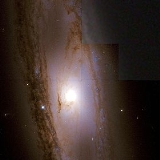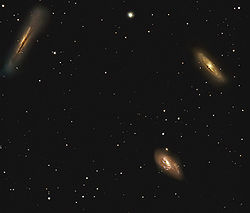
Messier 65
Encyclopedia
Messier 65 is an intermediate spiral galaxy
about 35 million light-year
s away in the constellation
Leo
. It was discovered by Charles Messier
in 1780. M65, M66
, and NGC 3628
comprise the famous Leo Triplet
, a small group of galaxies.
accidentally attributed the discovery to Pierre Méchain
in his popular 19th century astronomical work A Cycle of Celestial Objects (stating "They [M65 and M66] were pointed out by Méchain to Messier in 1780"). This error was in turn picked up by Kenneth Glyn Jones in Messier's Nebulae and Star Clusters. This has since ramified into a number of other books by a variety of authors.

Intermediate spiral galaxy
An intermediate spiral galaxy is a galaxy that is in between the classifications of a barred spiral galaxy and an unbarred spiral galaxy. It is designated as SAB in the galaxy morphological classification scheme.-Grades:...
about 35 million light-year
Light-year
A light-year, also light year or lightyear is a unit of length, equal to just under 10 trillion kilometres...
s away in the constellation
Constellation
In modern astronomy, a constellation is an internationally defined area of the celestial sphere. These areas are grouped around asterisms, patterns formed by prominent stars within apparent proximity to one another on Earth's night sky....
Leo
Leo (constellation)
Leo is one of the constellations of the zodiac. Its name is Latin for lion. Its symbol is . Leo lies between dim Cancer to the west and Virgo to the east.-Stars:...
. It was discovered by Charles Messier
Charles Messier
Charles Messier was a French astronomer most notable for publishing an astronomical catalogue consisting of deep sky objects such as nebulae and star clusters that came to be known as the 110 "Messier objects"...
in 1780. M65, M66
Messier 66
Messier 66 is an intermediate spiral galaxy about 36 million light-years away in the constellation Leo. It was discovered by Charles Messier in 1780...
, and NGC 3628
NGC 3628
NGC 3628, also known as Sarah's Galaxy, is an unbarred spiral galaxy about 35 million light-years away in the constellation Leo. It was discovered by William Herschel in 1784. It has an approximately 300,000 light-years long tidal tail. NGC 3628 along with M65 and M66 form the famous Leo...
comprise the famous Leo Triplet
Leo Triplet
The Leo Triplet is a small group of galaxies about 35 million light-years away in the constellation Leo. This galaxy group consists of the spiral galaxies M65, the M66, and the NGC 3628.-Members:...
, a small group of galaxies.
Discovery
M65 was discovered by Charles Messier and included in his Messier Objects list. However, William Henry SmythWilliam Henry Smyth
William Henry Smyth was an English sailor, hydrographer, astronomer and numismatist.-Private Life:...
accidentally attributed the discovery to Pierre Méchain
Pierre Méchain
Pierre François André Méchain was a French astronomer and surveyor who, with Charles Messier, was a major contributor to the early study of deep sky objects and comets.-Life:...
in his popular 19th century astronomical work A Cycle of Celestial Objects (stating "They [M65 and M66] were pointed out by Méchain to Messier in 1780"). This error was in turn picked up by Kenneth Glyn Jones in Messier's Nebulae and Star Clusters. This has since ramified into a number of other books by a variety of authors.
Star Formation
The galaxy is low in dust and gas, and there is little star formation in it, although there has been some relatively recently in the arms. The ratio of old stars to new stars is correspondingly quite high. In most wavelengths it is quite uninteresting, though there is a radio source visible in the NVSS, offset from the core by about two arc-minutes. The identity of the source is uncertain, as it has not been identified visually, or formally studied in any published papers.

